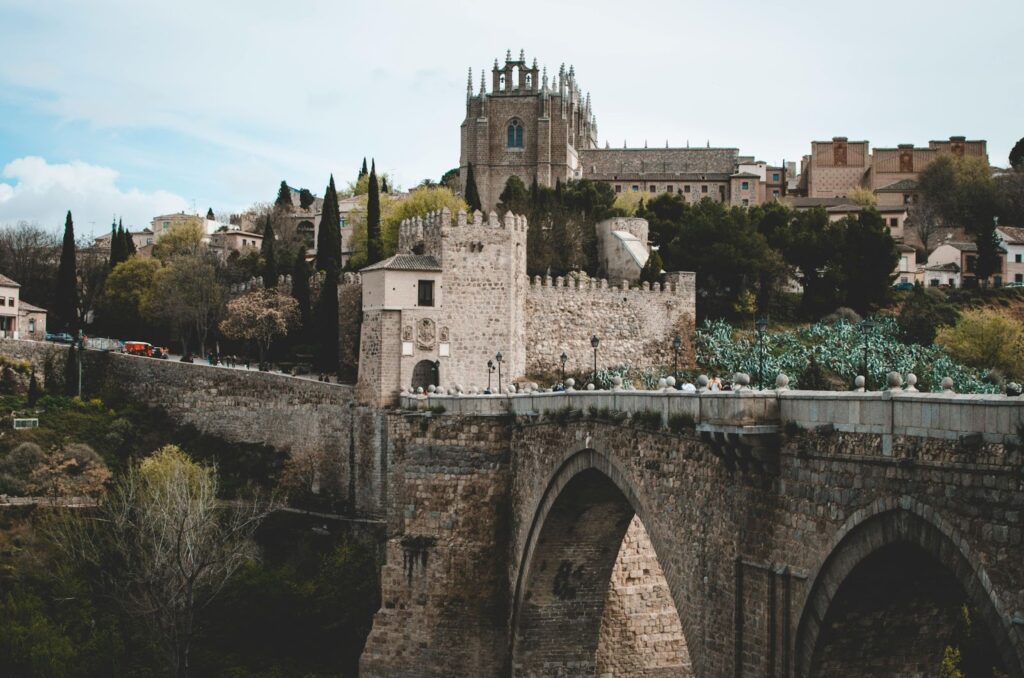The late-afternoon sun bathes a stone alley in golden light as the scent of cinnamon, honey, and olive oil wafts from a tiny bakery. In one bite, I taste history: flaky esquiladas pastries spiced with clove, a crispy matzá-like coca flatbread topped with fresh figs, and a chilled sip of salmorejo – Córdoba’s famed tomato gazpacho – garnished with a drizzle of olive oil. Each flavor tells a story. This isn’t your typical tapas crawl; it’s a journey through Spain’s Sephardic soul, a sensory adventure woven into a Jewish tour to Spain that connects cuisine with culture. Five centuries after the expulsion of 1492, Jewish culinary traditions linger in Spain’s kitchens, often hidden in plain sight. (Most Spaniards never realize that staples like hearty cocido stew or even holiday sweets such as roscos de vino trace back to medieval Jewish). As I travel from Catalonia to Andalucía, the very air seems seasoned with spice and story – the clove in a cookie whispering of secret Sabbaths, the orange-blossom in a pastry evoking patio gardens and ancient blessings. It’s a feast for the senses and a deep dive into history, all on one plate.
Barcelona
In Barcelona’s old town, the Gothic Quarter’s maze opens into El Call – the medieval Jewish district – where centuries-old doorways still bear Hebrew inscriptions. A short walk away, the trendy Born district beckons with historic bodegas (wine taverns) tucked beneath stone archways. Here, past and present mingle over food and drink. I perch at a barrel table in a rustic bodega, where I’m served a modern twist on a Sephardic favorite: Crisp golden eggplant slices drizzled with wild honey (berenjenas con miel) arrive, a dish that originated in Jewish kitchens of Al-Andalus but is now a beloved Spanish tapa.
The first bite is revelatory – hot, sweet, and slightly smoky – and it comes with a story from the owner: “In medieval times, eggplant was a Jewish staple, so much so that during the Inquisition, cooking it could arouse suspicion.” I learn that even Barcelona’s landscape holds memories: Montjuïc hill, overlooking the city, literally means “Jewish Mountain,” named for the old Jewish cemetery on its slopes. As twilight falls, I stroll through the Born’s lantern-lit lanes. A local chef tells me how he’s reviving Catalan-Jewish recipes – such as honey-glazed fried artichokes and wine-braised chicken with dried fruit – in his contemporary kitchen. There’s even a revived tradition of Friday-night gatherings: an intimate pop-up Shabbat dinner, held after closing time in a family-run restaurant, where guests savor slow-cooked lamb stew and raisin-flecked borekas (filled pastries) by candlelight, re-creating the warmth of a Sabbath meal.
The vibe in Barcelona is lively and experimental, yet deeply respectful of heritage. From nibbling on a slice of coca bread that recalls the unleavened matzot of old to clinking glasses of Catalan red wine as a subtle nod to kiddush, the city offers a flavorful homage to its Jewish roots. (Even the Catalan islands add to the tale – the Mallorca-born ensaïmada pastry, a coiled brioche, may have been a covert challah; local legend says converso bakers switched olive oil to lard in the recipe to prove their “conversion”.) In Barcelona, every bite comes with a taste of history and a dash of resilience.
Girona
An hour north of Barcelona, Girona feels like stepping back in time. In the medieval quarter, known as El Call de Girona, narrow cobblestone paths twist past ancient stone houses. I duck into a courtyard shaded by olive trees at the city’s Jewish Museum – once a synagogue in the 14th century – and feel a hush that is almost tangible. Sunlight filters into the Museu d’Història dels Jueus courtyard, illuminating a mosaic of a Star of David on the ground. It’s easy to sense the spiritual depth here. Girona was home to some of Sephardic Jewry’s greatest sages, and walking these lanes, one imagines rabbis in scholarly debate or families joyfully preparing for Sabbath long ago. I follow the sweet smell of almonds and find a bakery tucked near the old judería. They’re selling tortas de aceite – whisper-thin wafers made with olive oil, anise, and local wildflower honey. One crunchy bite and I’m transported; the recipe, the baker says, is inspired by Sephardic confections.
Because kosher rules forbade lard and butter with meat, Jewish cooks here became masters of olive oil pastries, a tradition alive in Girona’s confections today. I try a few: delicate cookies glazed with rosemary honey and orange zest, and buñuelos de viento (light fritters) fried in oil – treats that might easily have graced a Sephardic Hanukkah or Purim celebration. Beyond the sweets, Girona offers nourishing for the soul. In the dimly lit museum, I gaze at medieval gravestones and Hebrew manuscripts. The Sephardic legacy feels palpable – this city once thrived as a center of Kabbalah mysticism and Talmudic study.
As I wander the evocatively named “Street of the Jewries,” I feel a bridge between past and present. Girona’s Jewish heritage isn’t frozen in museum displays; it’s in the lingering aroma of cinnamon and honey in the streets, in the festivals where locals now celebrate their Sephardic past, and in the quiet pride of a community reclaiming its stories. The experience is equal parts culinary and spiritual – a honey cake for the taste buds and a historic revelation for the soul.
Córdoba
If Girona is a step back in time, Córdoba is a dance of cultures on the tongue. In this southern Andalusian city – once a cosmopolitan hub where Jewish, Muslim, and Christian traditions mingled – the flavors are intense and layered. By midday, I find myself in the old Jewish quarter of Córdoba, the Judería, beneath balconies draped with bougainvillea. I snack on almond-orange blossom pastries from a stand by the synagogue – dense little gems made of ground almonds, orange blossom water, and a touch of cinnamon. These rich, sweet morsels echo the medieval pastiellos and alfajores that Jewish and Moorish cooks perfected here centuries ago. Indeed, many of Andalusia’s famed sweets and drinks have Sephardic fingerprints: from aromatic almond cookies to herbal teas of pennyroyal and mint that still soothe after a hearty meal.
In a shaded patio, I sip a cool tisane of chamomile, imagining the great Jewish physician Maimonides (a native of Córdoba) approving of the digestive herbs. A plate of berenjenas con miel – lightly battered eggplant with a drizzle of dark cane honey – reminds me that some of the most iconic Andalusian dishes were pioneered by Jewish home cooks. (In fact, frying fish and vegetables in olive oil was a technique beloved by Sephardic families preparing Sabbath meals – the classic fried fish of southern Spain, pescaíto frito, was traditionally made on Fridays so it could be enjoyed cold on Saturday, a method that Sephardic Jews later carried to places as far as England.) Strolling past the 1315-era synagogue – one of the only three pre-Expulsion synagogues left in Spain – I run my fingers along its carved stucco walls. It stands quiet now, but once it rang with songs and prayers. A guide points out a nearby spice shop, noting how Jewish traders long ago helped introduce spices like cumin, saffron, and pepper to the Iberian kitchen. I inhale the warm, earthy fragrance emanating from its barrels of spices – a reminder that the Jewish impact on southern Spanish cuisine lives on in every pinch of seasoning.
History here isn’t just in textbooks; it’s in the food. Locals tell me how families in Córdoba still make a Sabbath stew much like the old adafina, simmering chickpeas overnight with beef, vegetables, and spices – except now many add a bit of bacon or chorizo, a post-Inquisition addition made when not eating pork became dangerous. Such anecdotes reveal the bittersweet truth: Jewish cooks profoundly influenced Andalusian gastronomy, even as they had to camouflage their identity. And yet, wandering Córdoba’s whitewashed lanes, where flamenco guitar strains mix with the call of street vendors selling candied almonds, I sense celebration over sorrow. Jewish heritage is now honored here – in museum exhibits, in restored houses like Casa de Sefarad, and of course in the flavors on the plate. Córdoba invites you to taste the complexity of convivencia – the coexistence – in every sweet and savory bite.
Madrid
Spain’s capital is a culinary capital as well, and lately its chefs have been looking to the past for inspiration. Madrid’s Jewish community is small but vibrant, and the city’s food scene – ever experimental – has begun to embrace kosher-style and Sephardic twists. One evening, I join a local friend on a “tapas hop” with a twist: we skip the ham and seek out the new wave of kosher-style tapas. In a cozy taberna near Plaza Mayor, we sample berenjenas a la miel (yes, that beloved eggplant with honey again, now served in elegant bite-size form) and lamb meatballs spiced with cumin and apricots – a tapa that fuses Middle Eastern and Spanish elements. The chef, it turns out, has Jewish roots from Tangier and proudly tells us he’s reimagining his grandmother’s Ladino recipes for modern diners.
Down the street at another eatery, we try crispy artichokes sprinkled with salt – “fried in olive oil, Jewish-style,” our server winks. It strikes me that Madrid, a city known for pork-heavy fare, is discovering that many of its classic dishes have Jewish antecedents. Take the emblematic cocido madrileño (a hearty chickpea stew): it evolved from a Sabbath stew, minus the pork, that nourished Jewish families in medieval Spain. Today, one innovative Madrid restaurant offers a “Convivienda” tasting menu – each course highlighting a different cultural influence. Here I taste adafina-inspired stew served in espresso cups as a rich soup, followed by pinchos of grilled eggplant with pomegranate molasses, a nod to Sephardic flavors. For dessert, there’s tarta de queso made with goat cheese and honey, reminiscent of old Jewish dairy desserts for Shavuot.
Madrid’s culinary revival isn’t happening in a vacuum. In recent years, descendants of Sephardic Jews from Turkey, Morocco, and beyond have reconnected with Spain, some even resettling here, bringing their treasured family recipes with them. I visit a chic new café run by a young couple – one from Madrid, one from Tel Aviv – who serve tapásikos: tapas-sized portions of Sephardic Jewish classics like boyos (spinach and cheese hand pies) and keftes de prasa (leek patties) alongside Spanish Rioja wine. The result is pure delight. It’s informal and friendly – you might hear Ladino songs playing softly over the speakers – and it underscores a beautiful fact: the Ladino language and cuisine, born in Spain and carried lovingly through the diaspora, are finding their way home. In Madrid’s multicultural kitchens, the past is present and truly delicious.
Shabbat & Community
On a Friday night in Spain, past and present often meet at the dinner table. I experienced an unforgettable Shabbat in a restored medieval home in Segovia: beneath timber beams and lantern light, twenty of us – locals and curious travelers – gathered around a long table set with braided challah loaves and red wine. As Hebrew prayers were sung, I felt goosebumps; it was as if the walls themselves were joining in, remembering the countless Sabbaths observed in secret during harsher times. Indeed, for centuries after 1492, many Jewish traditions in Spain survived only behind closed doors. (One friend from Seville recalls her grandmother’s odd habit of lighting two candles quietly every Friday at dusk – a family ritual with no stated reason. Only later did they realize it was a relic of their hidden Jewish past.)
The poignancy of those secret observances hits home when you learn about the lengths to which crypto-Jews went: some even devised recipes to “prove” their conversion, like a sweet known as chuletas – a faux pork chop made of bread, milk, and spices, served with tomato jam to resemble pork, so that nosy neighbors would be none the wiser. Today, thankfully, Jewish life in Spain is emerging from the shadows. Communities from Barcelona to Málaga now openly celebrate Shabbat.
In Barcelona, I joined a lively Kabbalat Shabbat service at an early-20th-century synagogue, its sanctuary filled with song and a mix of people from around the world. The shared dinner afterward featured çimçum (a Catalan-Jewish beef stew) and empanadikas (little meat pies) prepared by members of the congregation – a true community potluck bridging generations. Strikingly, Spain’s Jewish revival extends beyond physical gatherings. Embracing technology, local groups host digital culinary meet-ups that unite people globally.
One Sunday, I log onto a Zoom workshop from my Madrid hotel room: streaming live from Córdoba’s Jewish heritage center, a cook demonstrates how to make pestiños (anise-honey fritters) for Hanukkah. Participants chime in from four continents, mixing dough in their own kitchens while sharing memories of their Spanish-Jewish grandparents. It feels like a virtual potluck, filled with laughter, Ladino phrases, and the clatter of pans – a reminder that food has always been a connector for the Sephardic diaspora. Whether in person or online, these gatherings are emotional and affirming. There’s often a moment when someone raises a glass and says lechaim – “to life” – and you realize how miraculous it is that these traditions live on. In a country that once nearly erased its Jewish community, the simple act of blessing bread or passing down a recipe has become an act of joy, resilience, and reunion.
Take-Home Value
As my trek across Jewish Spain winds down, I’m eager to bring some of its magic home. If you embark on this journey, don’t forget to save room in your suitcase (and heart) for a few souvenirs and further explorations. First, the flavors: consider picking up a packet of smoky pimentón (paprika) or vibrant saffron from a market in Madrid – spices that feature prominently in Sephardic stews and desserts. A jar of local wildflower honey or a tin of artisanal olive oil from Andalucía will let you recreate that drizzle over eggplant or those olive-oil-fried treats back in your own kitchen.
In Toledo, I found a blend of cumin, coriander, and cinnamon labeled “Especias de Adafina” – a spice mix based on what medieval Jewish cooks used in their Sabbath stew. Sprinkling it into my dishes at home will instantly transport me to a Castilian hearth on a Friday afternoon. Beyond ingredients, the stories of Jewish Spain make for priceless takeaways. I’ve added a couple of unique books to my library: A Drizzle of Honey: The Lives and Recipes of Spain’s Secret Jews – a fascinating collection of historical recipes uncovered from Inquisition trial records – and a memoir-cookbook called Recipes of My 15 Grandmothers by Genie Milgrom, who traced her crypto-Jewish lineage through generations of handwritten recipes (including that deceptive “pork chop” dessert designed to fool the Inquisition).
These readings, rich with personal anecdotes and flavors, will deepen your appreciation for how closely food and identity intertwine. You might also seek out a Sephardic cookbook or two; for instance, acclaimed food writer Claudia Roden’s The Book of Jewish Food devotes whole chapters to the cuisine of Sepharad, from Catalan eggplant dishes to Moroccan-Sephardic tagines, and it contextualizes each recipe in history and geography. Finally, consider intangible souvenirs: the Ladino songs you heard in a Granada cafe (you can find recordings easily online), the blessings you learned at a Shabbat table, or the new friends you made at a community dinner.
These are things you can carry with you always. After all, the true gift of a Jewish foodie trek across Spain is a renewed sense of connection to a culture that has endured against the odds, to a tapestry of flavors that link past to present, and to the idea that sharing food can keep memories alive. As I leave Spain, I know that when I next fry eggplant in my kitchen or bake a batch of spice-scented cookies, I’ll hear echoes of Spain’s Jewish cooks in the sizzle and smell. In that moment, the journey continues – a delicious reminder that through food, history lives on, and we are all invited to the table.





